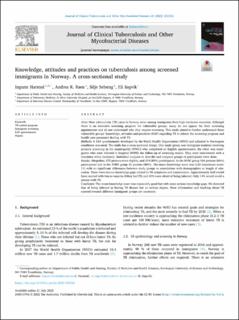| dc.contributor.author | Harstad, Ingunn | |
| dc.contributor.author | Raen, Andrea R. | |
| dc.contributor.author | Selseng, Silje | |
| dc.contributor.author | Sagvik, Eli Oline | |
| dc.date.accessioned | 2023-03-03T08:56:43Z | |
| dc.date.available | 2023-03-03T08:56:43Z | |
| dc.date.created | 2022-08-23T12:16:04Z | |
| dc.date.issued | 2022 | |
| dc.identifier.citation | Journal of Clinical Tuberculosis and Other Mycobacterial Diseases (JCTMD). 2022, 28 1-7. | en_US |
| dc.identifier.issn | 2405-5794 | |
| dc.identifier.uri | https://hdl.handle.net/11250/3055627 | |
| dc.description.abstract | Aims
Most tuberculosis (TB) cases in Norway occur among immigrants from high-incidence countries. Although there is an extensive screening program for vulnerable groups, many do not appear for their screening appointment and do not understand why they require screening. This study aimed to further understand these vulnerable groups’ knowledge, attitudes and practices (KAP) regarding TB to inform the screening program and health care personnel dealing with TB.
Methods
A KAP questionnaire developed by the World Health Organization (WHO) and adjusted to Norwegian conditions was used. The study has a cross-sectional design. One study group was immigrant students receiving primary screening in the municipality (MVIC) who completed an English questionnaire; the other was immigrants who were referred to hospital (POPD) for follow-up of screening results. They were interviewed with a translator when necessary. Statistical analyses to describe and compare groups of participants were done.
Results
Altogether, 275 persons were eligible, and 219 (85%) participated. In the MVIC group 184 persons (86%) participated and in the POPD group 35 persons (80%). The mean knowledge score was 5.53 (maximum score: 11) with no significant differences between study groups or associations with demographics or length of education. There were serious knowledge gaps related to TB symptoms and transmission. Approximately half would have reacted with fear or surprise if they had TB, and 60% were afraid of being infected. Only 14% would avoid a person with TB.
Conclusion
The mean knowledge score was reasonably good but with some serious knowledge gaps. We detected fear of being infected or having TB disease but no serious stigma. More information and teaching about TB catered towards different immigrant groups are necessary. | en_US |
| dc.language.iso | eng | en_US |
| dc.publisher | Elsevier | en_US |
| dc.rights | Navngivelse 4.0 Internasjonal | * |
| dc.rights.uri | http://creativecommons.org/licenses/by/4.0/deed.no | * |
| dc.title | Knowledge, attitudes and practices on tuberculosis among screened immigrants in Norway. A cross-sectional study | en_US |
| dc.title.alternative | Knowledge, attitudes and practices on tuberculosis among screened immigrants in Norway. A cross-sectional study | en_US |
| dc.type | Peer reviewed | en_US |
| dc.type | Journal article | en_US |
| dc.description.version | publishedVersion | en_US |
| dc.source.pagenumber | 1-7 | en_US |
| dc.source.volume | 28 | en_US |
| dc.source.journal | Journal of Clinical Tuberculosis and Other Mycobacterial Diseases (JCTMD) | en_US |
| dc.identifier.doi | 10.1016/j.jctube.2022.100326 | |
| dc.identifier.cristin | 2045289 | |
| cristin.ispublished | true | |
| cristin.fulltext | original | |
| cristin.qualitycode | 1 | |

